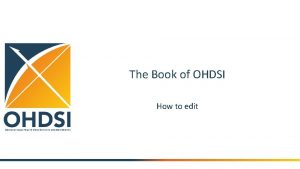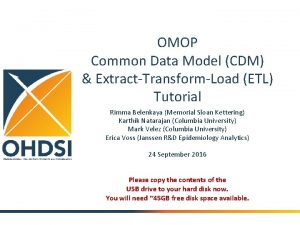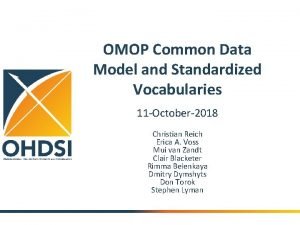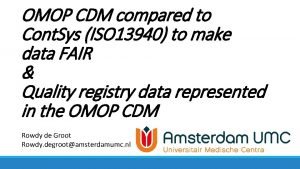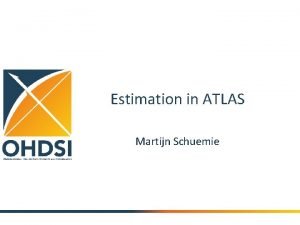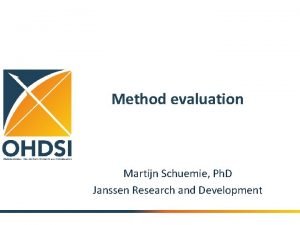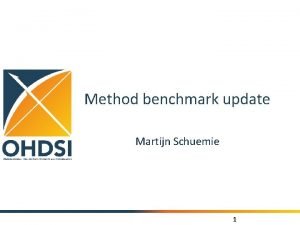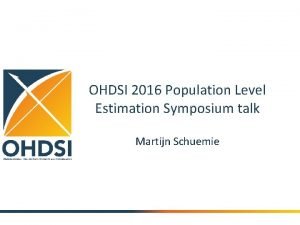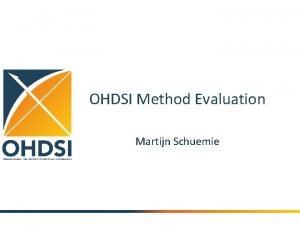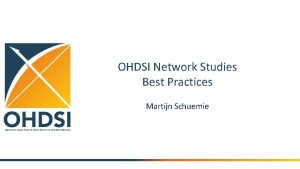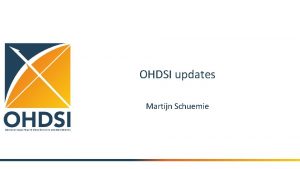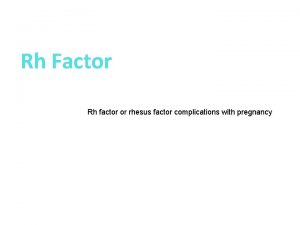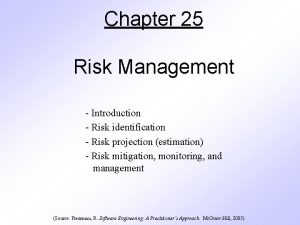An OHDSI approach to risk factor identification Martijn























- Slides: 23

An OHDSI approach to risk factor identification Martijn Schuemie

Announcement 1 Empirical CI calibration paper published in PNAS! 2

Announcement 2 LEGEND Large-scale Evidence Generation and Evaluation in a Network of Databases 3

Announcement 3 Cohort. Method plot. Kaplain. Meier now works for variable ratio matching and stratification! 4

Announcement 4 Cohort. Method create. Cm. Table 1 creates table 1 for your comparative cohort study! 5

Risk factors Ambiguity around what is a “risk factor”: • Something associated with the outcome? • Something that causes the outcome? • An effect modifier? 6

Kraemer HC, Kazdin AE, Offord DR, Kessler RC, Jensen PS, Kupfer DJ. Coming to terms with the terms of risk. Arch Gen Psychiatry. 1997 Apr; 54(4): 337 -43. 7

E. g. eye color and lung cancer Kraemer HC, Kazdin AE, Offord DR, Kessler RC, Jensen PS, Kupfer DJ. Coming to terms with the terms of risk. Arch Gen Psychiatry. 1997 Apr; 54(4): 337 -43. 8

E. g. antibiotics and infections Kraemer HC, Kazdin AE, Offord DR, Kessler RC, Jensen PS, Kupfer DJ. Coming to terms with the terms of risk. Arch Gen Psychiatry. 1997 Apr; 54(4): 337 -43. 9

E. g. alcohol and lung cancer Kraemer HC, Kazdin AE, Offord DR, Kessler RC, Jensen PS, Kupfer DJ. Coming to terms with the terms of risk. Arch Gen Psychiatry. 1997 Apr; 54(4): 337 -43. 10

E. g. ‘family history of breast cancer’ and breast cancer Kraemer HC, Kazdin AE, Offord DR, Kessler RC, Jensen PS, Kupfer DJ. Coming to terms with the terms of risk. Arch Gen Psychiatry. 1997 Apr; 54(4): 337 -43. 11

E. g. alcohol and lung cancer Kraemer HC, Kazdin AE, Offord DR, Kessler RC, Jensen PS, Kupfer DJ. Coming to terms with the terms of risk. Arch Gen Psychiatry. 1997 Apr; 54(4): 337 -43. 12

E. g. smoking and lung cancer Kraemer HC, Kazdin AE, Offord DR, Kessler RC, Jensen PS, Kupfer DJ. Coming to terms with the terms of risk. Arch Gen Psychiatry. 1997 Apr; 54(4): 337 -43. 13

Univariable definition of risk factor p(y=1 | xi=1) > p(y=1) Observing the preceding factor xi increases the probability of the outcome (y=1) E. g. both alcohol and smoking are risk factors for lung cancer 14

Multivariable definition of risk factor p(y=1 | xi=1, Xj≠i) > p(y=1 | Xj≠i) Observing the preceding factor xi , given all other observed preceding factors, increases the probability of the outcome (y=1) E. g. is alcohol still a risk factor for lung cancer after accounting for smoking? 15

Identifiability in multivariate definition Colinearity of factors poses a problem: Smoking Lung cancer Alcohol Given smoking, alcohol is not predictive Given alcohol, smoking is not predictive 16

Solution • Traditional: – Only consider a handful of (arbitrarily) selected variables. – Fit regression model. • LASSO: – Use regularized regression – All but one correlated variable will be shrunk to zero – Loss of information? (e. g. smoking might get shrunk) 17

Proposed solution • ‘Risk factor analysis’ – Combine correlated variables into ‘factors’ – ‘factor’ as in ‘factor analysis’: hidden variable in a lower-dimensional space – Perform regression on factors 18

Demonstration Task: Find risk factors of stroke in people with depression 1. 2. 3. 4. Define T (people with depression) and O (stroke) Define time-at-risk: 1 year following cohort entry Extract baseline covariates using Feature. Extraction Identify factors – – Principle Component Analysis Latent Dirichlet Allocation 5. Transform features to factors 6. Fit logistic regression – – X = factors y = stroke 19

Demonstration • • MDCD database 123, 861 people in target cohort 517 outcomes in time-at-risk Shiny app 20

Conclusions • Univariable definition of ‘risk factors’ is clear • Unclear how this extends to multivariable space • Current solutions (hand-picking, LASSO) have issues • Identifying lower-dimensional factors might help • More research needed 21

Topic of next meeting(s)? • ? 22

Next workgroup meeting Western hemisphere: March 29 • 6 pm Central European time • 12 pm New York • 9 am Los Angeles / Stanford Eastern hemisphere: April 4 • 3 pm Hong Kong / Taiwan • 4 pm South Korea • 4: 30 pm Adelaide • 9 am Central European time • 8 am UK time http: //www. ohdsi. org/web/wiki/doku. php? id=projects: workgroups: est-methods 23
 Liquidity measures
Liquidity measures Central pocket vs plain whorl
Central pocket vs plain whorl The book of ohdsi
The book of ohdsi Omop cdm tables
Omop cdm tables Ohdsi phenotype library
Ohdsi phenotype library Book of ohdsi
Book of ohdsi Ohdsi in a box
Ohdsi in a box Iso 13940
Iso 13940 Ohdsi atlas demo
Ohdsi atlas demo Martijn schut
Martijn schut Martijn nolen
Martijn nolen Martijn weesing
Martijn weesing Martijn van de voort
Martijn van de voort Martijn schuemie
Martijn schuemie Martijn priem
Martijn priem Martijn van iersel
Martijn van iersel Martijn van breden
Martijn van breden Martijn corbee
Martijn corbee Martijn koops
Martijn koops Martijn tennekes
Martijn tennekes Benchmark
Benchmark Martijn schuemie
Martijn schuemie Martijn schuemie
Martijn schuemie Tableplot
Tableplot


